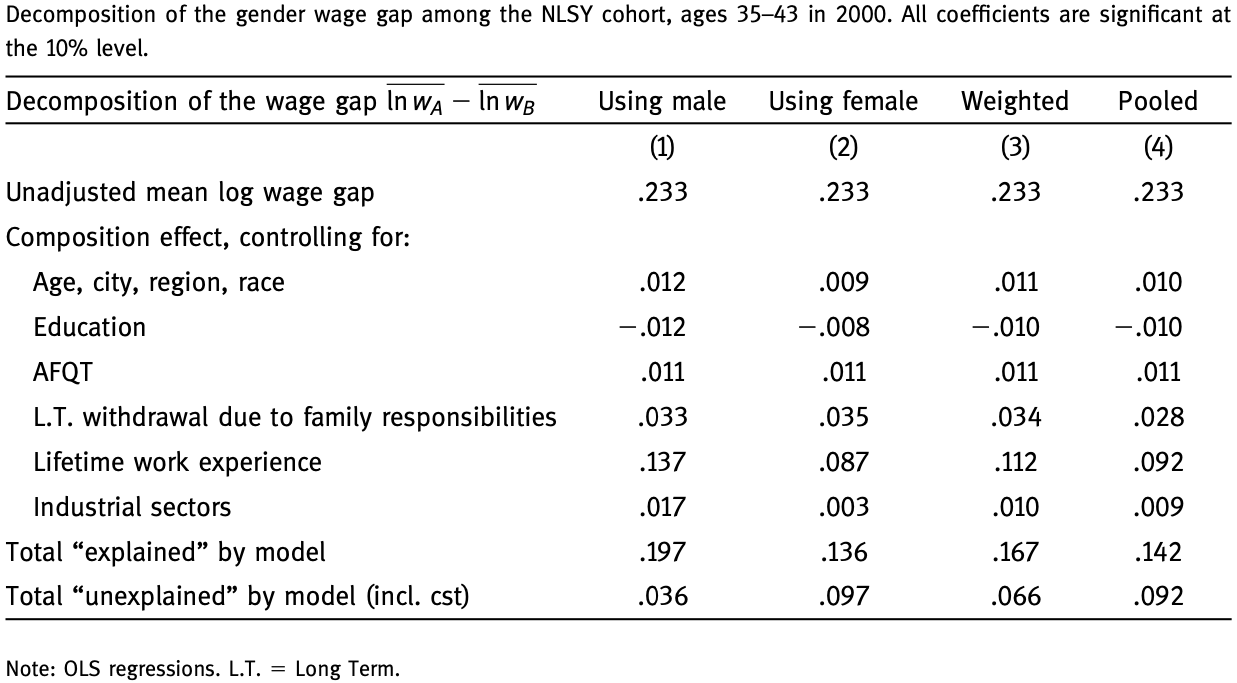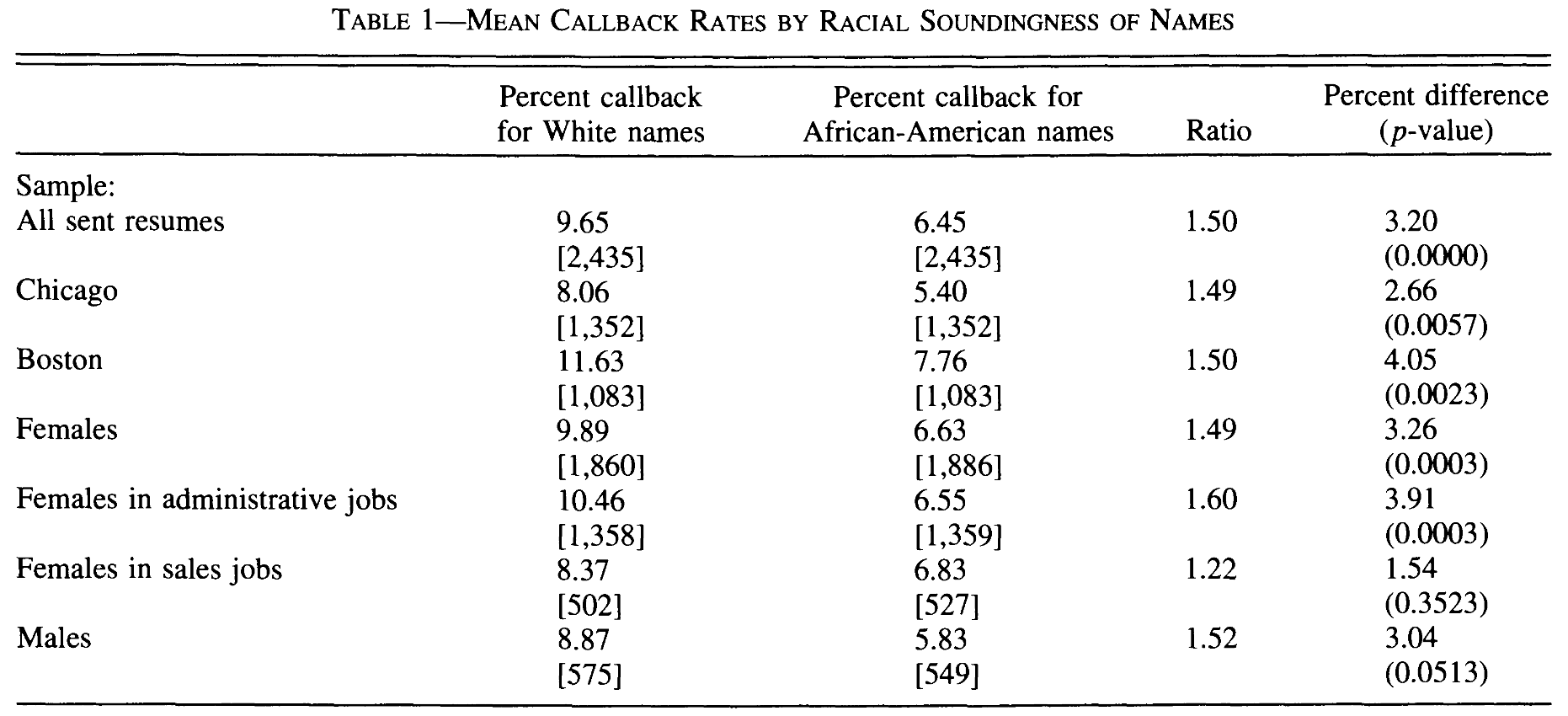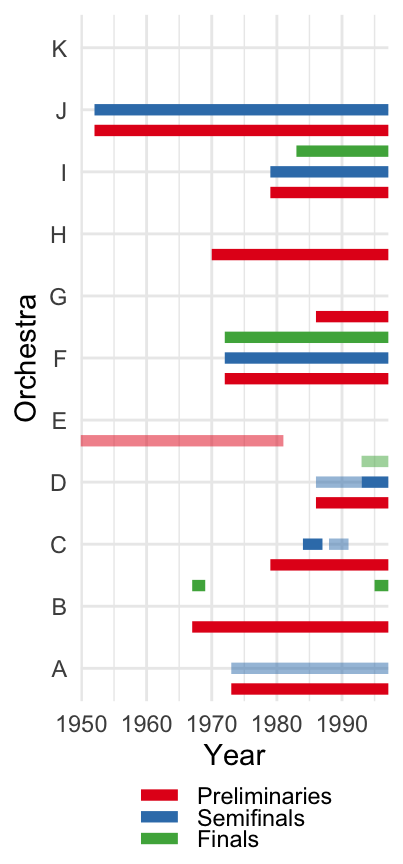
9. Labour market discrimination
KAT.TAL.322 Advanced Course in Labour Economics
September 22, 2025
Same level of productivity, different outcomes based on nonproductive characteristics
Employers may discriminate in hiring/firing decisions
Co-workers may discriminate in collaboration activity
Customers may discriminate in purchase decisions
Taste discrimination
Taste discrimination
First formalized by Becker (1957)
- There are two types of workers A and B
- Perfect substitutes: F(A+B)⇒FA=FB
A firm decides how many workers to employ to maximise the utility
maxA,BPF(A+B)−wAA−wBB−dB
where d≥0 is the disutility employer gets from worker B
Taste discrimination
FOCs:
PFA(A+B)=wAPFB(A+B)=wB+d
Hire B iff wB+d≤wA
Taste discrimination
Perfect competition and free entry
Non-discriminating firms d=0 enters the market
Pay competitive wages to both groups wA=wB=PFL(L)
Therefore,
- discriminating firms hire A workers at wA
- non-discriminating firms hire everyone at wA=wB=w
Taste discrimination cannot persist under perfect competition
Taste discrimination
Imperfect competition
Monopsonistic employer
Lower wages and lower employment of discriminated group
Market frictions (Black 1995)
Job search costs:
- Existence of employers with d>0 lowers reservation wage
- Wages of discriminated workers at non-discriminating firms are also lower
- Longer unemployment until meet non-discriminating firm
Statistical discrimination
Statistical discrimination
Overview
Key feature: unobservable productivity
- Suppose firms meets workers Ai and Bj such that FAi=FBi
- Firm doesn’t see FAi or FBi, only group identities A and B
- If firms believe that E(FA)≥E(FB), then ↑wA and ↑LA
Statistical discrimination
Two types of workers: high h+>0 and low h−=0
Employers know the overall share of efficient workers π(h+)≡π
Employers use costless test to infer worker types and hire if passed
- Pr(pass|h+)=1
- Pr(pass|h−)=p where p∈[0,1]
Average productivity of workers passing the test (≡w)
w≡E(h|pass)=h+ππ+p(1−π)
Statistical discrimination
Self-fulfilling prophecies
Workers choose education to maxe∈{0,1}U(w,e)=maxew−e
If e=1⇒ achieve productivity h+, otherwise, h−
w+≡E(h|pass)=h+ππ+p(1−π)E(w|e=0)=pw+
Optimal decision e=1⇔w+−1≥E(w|e=0)⇒p≤π[(h+−1)(1−p)]
Statistical discrimination
Multliple equilibria and persistent inequalities

Source: Figure 5.7 (Cahuc 2004)
Systemic discrimination
Systemic discrimination (Bohren, Hull, and Imas 2025)
Discrimination in one area has spillover effects on other areas
Let’s consider two programmers: male (M) and female (F)
Systemic discrimination (Bohren, Hull, and Imas 2025)
Discrimination in one area has spillover effects on other areas
They submit codes C0M≡C0F to open-source software
Systemic discrimination (Bohren, Hull, and Imas 2025)
Discrimination in one area has spillover effects on other areas
They receive performance ratings PM and PF
Systemic discrimination (Bohren, Hull, and Imas 2025)
Discrimination in one area has spillover effects on other areas
Apply for jobs with signals SM=(PM,RM) and SF=(PF,RF)
Systemic discrimination (Bohren, Hull, and Imas 2025)
Discrimination in one area has spillover effects on other areas
Employer’s hiring decision AM(M,SM) and AF(F,SF)
Decomposition (Bohren, Hull, and Imas 2025)
Direct discrimination
For a given signal S, δ(S)≡A(M,S)−A(F,S)≠0
Total discrimination
Let G(A|C0,i) be distribution over all possible actions given identity i and initial condition C0.
ΔT(C0)≡EG[A|C0,M]−EG[A|C0,F]≠0
Systemic discrimination
Let ˜G(A|C0,i) be distribution over actions under original signal distribution but A(−i,S)
ΔS(C0,M)≡EG[A|C0,M]−E˜G[A,C0,F]
ΔS(C0,F)≡E˜G[A|C0,M]−EG[A,C0,F]
Decomposition
Let Σ(S|C0,i) be distribution over all possible signals given identity i and initial condition C0
ΔT(C0)=EΣ[δ(S)|C0,M]+ΔS(C0,F)
ΔT(C0)=EΣ[δ(S)|C0,F]+ΔS(C0,M)
Empirical results
Measuring discrimination
Δ Wage by non-productive characteristics given same productivity.
Empirical challenges
- What constitutes a productive vs non-productive characteristic?
- Is Δ wage attributable to discrimination alone or worker preferences?
- Does the discrimination arise from tastes or unobserved information?
Types of studies
- Observational
- Audit and correspondence studies
- Lab and field experiments
- Quasi-random variation
Kitagawa-Oaxaca-Blinder1 decomposition
Wages in two groups (A and B) can be written
lnwA=xAβA+εA,E(εA)=0lnwB=xBβB+εB,E(εB)=0
Then, average wage differential
Δ≡E(lnwA)−E(lnwB)=[E(xA)−E(xB)]βA+E(xB)(βA−βB)
decomposed into explained and unexplained components.
Kitagawa-Oaxaca-Blinder decomposition
Interpretation
- Common support: xA and xB contain same set of variables with similar value
- Conditional mean independence: E(εA|xA)=E(εB|xB)=0
- Invariance of conditional distributions: distribution of wA|xA remains unchanged if B workers receive returns βA
These are very strict assumptions, so the decomposition is a correlational (not causal) measure.
Kitagawa-Oaxaca-Blinder decomposition

Source: Table 8.5 (Cahuc 2004)
Audit (correspondence) studies
- Send fictitious CVs nearly identical except in group membership
- Measure callback (interview invitations, offers) received
- RCT ⇒ group differences can be interpreted as discrimination
Challenges
- CVs may not convey all relevant productive characteristics
- Cannot disentangle taste discrimination from statistical
- Harder to generalize
Bertrand and Mullainathan (2004)
Created templates for CVs of jobseekers in Boston and Chicago
- high and low quality types based on experience, skills, career profiles
- randomly assign distinctively White or African-American name
- track callback/email rates in race/sex/city/quality cell
| White names | African-American | |
|---|---|---|
| College degree | 0.720 | 0.720 |
| (0.450) | (0.450) | |
| Years of experience | 7.860 | 7.830 |
| (5.070) | (5.010) | |
| Computer skills? | 0.810 | 0.830 |
| (0.390) | (0.370) | |
| Obs. | 2 435 | 2 435 |
Source: Table 3 (Bertrand and Mullainathan 2004)
Bertrand and Mullainathan (2004)

Goldin and Rouse (2000)
Pre-1970s, musicians handpicked by the director
In 1970s-80s, auditions
- “open and routinized”
- blind (some stages)
Staggered adoption of screen: DiD method

Goldin and Rouse (2000)
Results
| Preliminaries | ||||
|---|---|---|---|---|
| Without semifinals | With semifinals | Semifinals | Finals | |
| Female x Blind | 0.111 | -0.025 | -0.235 | 0.331 |
| (0.067) | (0.251) | (0.133) | (0.181) | |
| Obs. | 5 395 | 6 239 | 1 360 | 1 127 |
| R2 | 0.775 | 0.697 | 0.794 | 0.878 |
Source: Table 6 (Goldin and Rouse 2000)
Mobius and Rosenblat (2006)
Lab experiment: taste discrimination based on beauty
Participants randomly assigned as workers (5) and employers (5).
Workers answer survey and solve simplest maze game
Survey + practice time = digital CV
Confidence: predict # mazes solved in 15 min (private)
100Aj−40|Cj−Aj|, where Aj actual and Cj predicted performance
Mobius and Rosenblat (2006)
Workers randomly matched to employers (5×5)
B CV only (baseline) V CV + (visual) O CV + (oral) VO CV + + (visual and oral) FTF CV + + (face-to-face) Employers set wages wij = # mazes could solve in 15 min Πi=4000−40∑5j=1|wij−Aj|
Workers complete 15 min “employment”: realised Aj
Mobius and Rosenblat (2006)
- Payoffs
Firms receive Πi as on previous slide
Workers receive Πj=100Aj−40|Cj−Aj|+∑5i=1Wij where Wij={100wijwith probability 80%ˉwjwith probability 20%
Employers know if Wij=100wij before setting it!
Mobius and Rosenblat (2006)
Results
Beauty does not affect actual performance, but ↑ confidence
Beauty premia, but no taste-based discrimination
B V O VO FTF BEAUTY 0.017 0.131** 0.129** 0.124** 0.167** (0.040) (0.042) (0.034) (0.036) (0.043) SETWAGE -0.010 -0.072 0.098* -0.046 0.033 (0.055) (0.052) (0.046) (0.048) (0.057) SETWAGE x BEAUTY -0.058 -0.099+ 0.005 -0.022 -0.044 (0.057) (0.053) (0.048) (0.050) (0.058) N 163 161 163 162 163 Source: Table 4 (Mobius and Rosenblat 2006)
Beauty premium: 15-20% due to confidence, 40% - stereotype
Rao (2019)
Field and lab experiments eliciting taste-based discrimination
Δ policy in India: elite schools offer free places to poor students
Exploit staggered implementation using DiD
- more charitable
- changes fundamental notions of fairness and generosity
- reduce discrimination (teammate choice in race)
- high stakes: only 6% choose slower rich over faster poor student
- low stakes: 33% discriminate against poor students
- past exposure ↓ taste discrimination WTP by 12pp
Doleac and Hansen (2020)
Quasi-random policy experiment measuring statistical discrimination
Ban-the-box (BTB) policy
- Banning prior criminal convictions box on job applications
- Hawaii in 1998 ⟶ 34 states + DC in 2015
BTB “does nothing to address the average job readiness of ex-offenders”.
Therefore, statistical discrimination may ↑
Use DiD to measure effect of BTB on employment of minorities
Doleac and Hansen (2020)
| Full sample | BTB-adopting | |
|---|---|---|
| White x BTB | -0.003 | -0.005 |
| (0.006) | (0.008) | |
| Black x BTB | -0.034** | -0.031** |
| (0.015) | (0.014) | |
| Hispanic x BTB | -0.023* | -0.020 |
| (0.013) | (0.015) | |
| Obs. | 503,419 | 231,933 |
| Pre-BTB baseline | ||
| White | 0.8219 | 0.8219 |
| Black | 0.677 | 0.677 |
| Hispanic | 0.7994 | 0.7994 |
Source: Table 4 (Doleac and Hansen 2020)
Glover, Pallais, and Pariente (2017)
Capturing self-fulfilling prophecy of statistical discrimination
Quasi-random assignment of new cashiers to managers in French stores
Do minority cashiers perform worse with biased managers?
Measure manager bias using Implicit Association Test (IAT)
- 66% moderate to severe bias
- 20% slight bias
Outcomes: absences, time worked, scanning speed, time between customers
Glover, Pallais, and Pariente (2017)
| Absences | Overtime (min) | Scan per min | Inter-customer time (sec) | |
|---|---|---|---|---|
| Minority x Mngr bias | 0.012*** | -3.237* | -0.249** | 1.360** |
| (0.004) | (1.678) | (0.111) | (0.665) | |
| Obs. | 4,371 | 4,163 | 3,601 | 3,287 |
| Dep var mean | 0.0162 | -0.068 | 18.53 | 28.7 |
Sources: Tables III and IV (Glover, Pallais, and Pariente 2017)
Bohren, Hull, and Imas (2025)
Role of gendered recommendation letters on hiring
- LLM: “female” and “male” recommendation letters
- Fictitious CVs with “male” and “female” names
- Survey 396 hiring managers
| Recommendation gender | ||
| CV name | CV | CV |
| CV | CV |
Bohren, Hull, and Imas (2025)


Summary
Two main frameworks with different implications for labour markets
- Taste-based discrimination
- Statistical discrimination
Systemic discrimination accumulating over time
Simple decomposition to measure unexplained gap
Vast experimental and quasi-experimental literature
Next lecture: Intergenerational mobility on 24 Sep